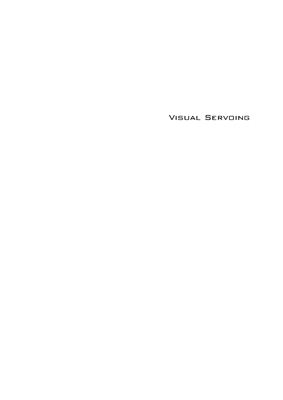Издательство InTech, 2010, -244 pp.
In the machine vision field, the theory has been studied for many decades. Fortunately, the computer technique is also developed rapidly simultaneously. Recently, these theories of machine vision have been realized practically in variety applications. The machine vision system consists of the optics, electronics, machinery and the computer information technology systematically. The technique is applied widely industrially including vision servoing trajectory motion control, optical measurement and automatic examination, patte identification and system monitoring and so on. The advantages of the vision system are the non-contact measurement, versatility, cost effectiveness, and practicality. Therefore, the machine vision technology can be investigated and studied enthusiastically to improve the industrial development and human engineering.
In the field of machine vision, there are many technique books about introducing the fundamental theory of vision. But there is not a book about how to employ the vision theory in the market conditions for students or researchers who want to realize the technique of machine vision. It is meaningful to employ the vision theory to the practical application, and the vision theory can also be employed originally by different field researchers.
I am pleasant that the book consists of 10 chapters by different fields about vision applications. The authors in chapters are excellent in their research fields. It is honored to collect the 10 chapters that depict the multiplicity of the vision theory by the authors. For the readers, you can select some kinds of applications you are interesting in this book, and to study the detailed contents in each chapter. This book collects the main studies about machine vision currently in the world, and has a powerful persuasion in the applications employed in the machine vision. The contents, which demonstrate that the machine vision theory, are realized in different field. For the beginner, it is easy to understand the development in the vision servoing. For engineer, professor and researcher, they can study and lea the chapters, and then employ another application method.
The goal of this book is to introduce the visional application by excellent researchers in the world currently and offer the knowledge that can also be applied to another field widely. This present book provides the diversified applications to visual technique. In the content of this book, there are two main parts that consist of vision servoing control (chapters 1~5) and vision servoing application (chapters 6~10).
A Modeling and Simulation Platform for Robot Kinematics aiming Visual Servo Control
Models and Control Strategies for Visual Servoing
The Uncalibrated Microscope Visual Servoing for Micromanipulation Robotic System
Human-in-the-Loop Control for a Broadcast Camera System
Vision-Based Control of the Mechatronic System
Online 3-D Trajectory Estimation of a Flying Object from a Monocular Image Sequence for Catching
Multi-Camera Visual Servoing of a Micro Helicopter Under Occlusions
Model Based Software Production Utilized by Visual Templates
Visual Servoing for UAVs
Video Watermarking Technique using Visual Sensibility and Motion Vector
In the machine vision field, the theory has been studied for many decades. Fortunately, the computer technique is also developed rapidly simultaneously. Recently, these theories of machine vision have been realized practically in variety applications. The machine vision system consists of the optics, electronics, machinery and the computer information technology systematically. The technique is applied widely industrially including vision servoing trajectory motion control, optical measurement and automatic examination, patte identification and system monitoring and so on. The advantages of the vision system are the non-contact measurement, versatility, cost effectiveness, and practicality. Therefore, the machine vision technology can be investigated and studied enthusiastically to improve the industrial development and human engineering.
In the field of machine vision, there are many technique books about introducing the fundamental theory of vision. But there is not a book about how to employ the vision theory in the market conditions for students or researchers who want to realize the technique of machine vision. It is meaningful to employ the vision theory to the practical application, and the vision theory can also be employed originally by different field researchers.
I am pleasant that the book consists of 10 chapters by different fields about vision applications. The authors in chapters are excellent in their research fields. It is honored to collect the 10 chapters that depict the multiplicity of the vision theory by the authors. For the readers, you can select some kinds of applications you are interesting in this book, and to study the detailed contents in each chapter. This book collects the main studies about machine vision currently in the world, and has a powerful persuasion in the applications employed in the machine vision. The contents, which demonstrate that the machine vision theory, are realized in different field. For the beginner, it is easy to understand the development in the vision servoing. For engineer, professor and researcher, they can study and lea the chapters, and then employ another application method.
The goal of this book is to introduce the visional application by excellent researchers in the world currently and offer the knowledge that can also be applied to another field widely. This present book provides the diversified applications to visual technique. In the content of this book, there are two main parts that consist of vision servoing control (chapters 1~5) and vision servoing application (chapters 6~10).
A Modeling and Simulation Platform for Robot Kinematics aiming Visual Servo Control
Models and Control Strategies for Visual Servoing
The Uncalibrated Microscope Visual Servoing for Micromanipulation Robotic System
Human-in-the-Loop Control for a Broadcast Camera System
Vision-Based Control of the Mechatronic System
Online 3-D Trajectory Estimation of a Flying Object from a Monocular Image Sequence for Catching
Multi-Camera Visual Servoing of a Micro Helicopter Under Occlusions
Model Based Software Production Utilized by Visual Templates
Visual Servoing for UAVs
Video Watermarking Technique using Visual Sensibility and Motion Vector

